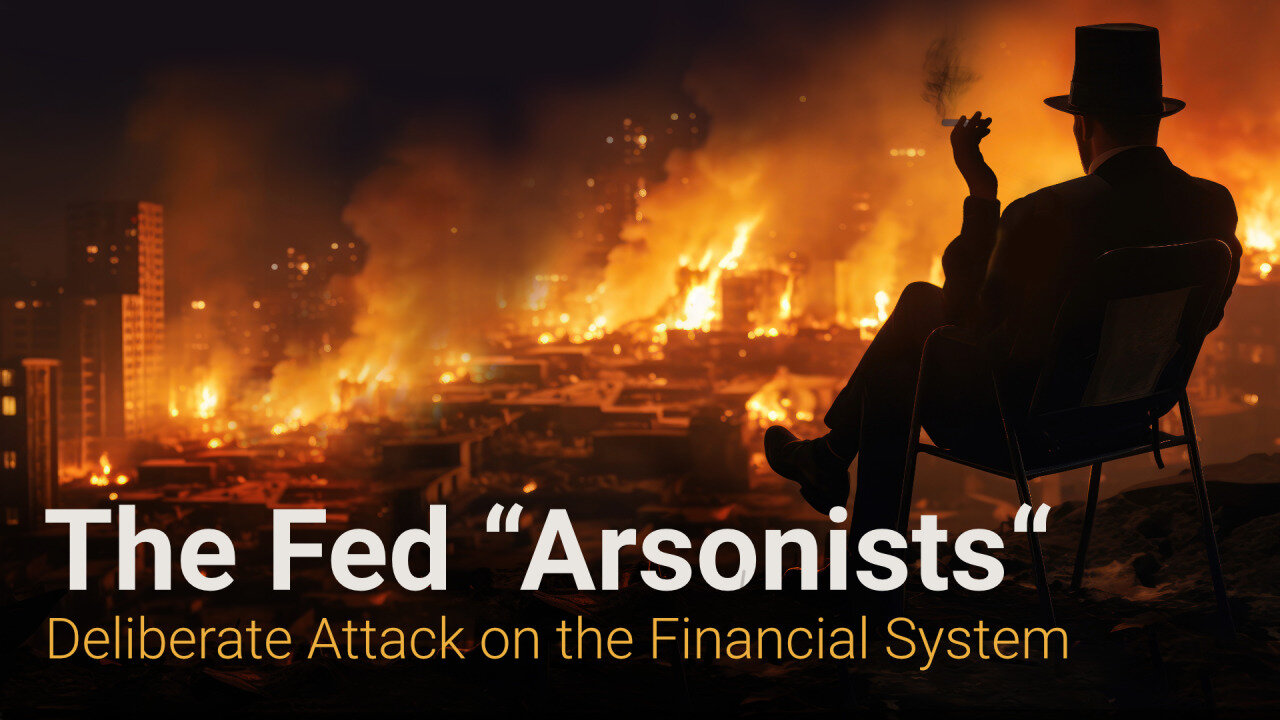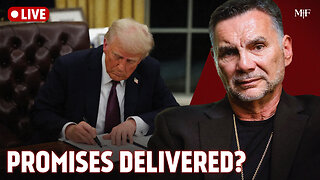Premium Only Content

Deliberate Attack on the Financial System! – US Central Bank Fed, an ...
Deliberate Attack on the Financial System! – US Central Bank Fed, an Arsonist within the Financial System
In 2023, the collapse of the Swiss Banking giant, Credit Suisse, and the US banks Signature, Silvergate, and Silicon Valley Bank (SVB) shook the financial markets. It was mainly the FED’s [Fed = Federal Reserve System], i.e. the US Central Bank’s monetary policy triggering this. At the end of 2021, the Fed had dramatically increased interest rates, which led to a fall in government bonds’ prices, as well as high losses in the bank’s credit lending and leasing businesses, and ultimately, to the collapse of these banks. In the entire US banking system, the Fed’s monetary policy wiped out an unbelievable amount of approximately 1.9 trillion US dollars.
In response to its self-inflicted crisis on the financial system, and the impending collapse of other US Banks, the Fed then launched the Bank Term Funding Program (BTFP) This program allowed US banks to access the Fed’s funds directly via loans and thus quietly solve their liquidity problems. As a result, the crisis calmed down and the Fed was once again able to present itself as the vigorous savior of the financial system. However, the problems in the US banking sector were of course by no means resolved. In fact, it is currently experiencing a historic crisis! See in the following how extensive this crisis is, the role the Fed is playing and what its motives and backgrounds are.
Part I. The Historic Crisis in the US Banking Sector
1. The Crisis in the US Commercial Real Estate Market
Today, there are more than 4,000 banks in the US, but only a few hundred of them can be viewed as healthy. The vast majority, on the other hand, are literally on the brink of collapse. One of the main reasons for this is a collapse of historic proportions in commercial real estate prices. The following examples illustrate just how significant this is: The 23-storey Prime Manhattan Office Tower in New York, valued at 215 million dollars in 2019, is now worth just 104 million dollars – a loss in value of 51.6 percent in just five years. In St. Louis, the tallest office building – the 44-storey AT&T tower – was sold for 3.5 million dollars. In 2006, this prime property still cost 205 million dollars, which represents a shocking 98% drop in value! Barry Sternlicht, a billionaire real estate investor, predicted losses of 1 trillion dollars in US office real estate alone as a result of this steep decline in prices. These losses are mostly found in the books of small and medium-sized US banks, which are now sitting on piles of bad loans, 30% to 50% of which are at acute risk of default, according to precious metals expert Dominik Kettner.
In addition, commercial real estate loans amounting to USD 560 billion will expire by the end of 2025 and more than USD 2.8 trillion will expire by the end of 2028. This means that banks in the USA are also facing a refinancing wave of historic proportions. This leads to the affected properties having to be refinanced at much less favourable conditions. If this is not successful, they will have to be sold at a large discount and with corresponding losses for the banks, which could lead to a collapse of the banking system. There has never been a comparable situation on the financial market before.
2. The Crisis in the US Bond Market
In addition to the crisis in the US commercial real estate market, another time bomb is ticking in the bond market. Rising interest rates have created a situation that also has the potential to shake the entire banking system. They opened up new attractive investment opportunities, leading to hardly any demand left for US government bonds. As a result, they lost value perilously, so that US banks are now sitting on a stockpile of unrealized losses amounting to over 516 billion US dollars. As long as the banks hold these bonds, the losses remain “on paper”. But if, for example, customers withdraw their deposits or the banks are forced to sell these bonds for other reasons, the losses become real and could also trigger a banking crash.
3. The Fed Ends the Bank Term Funding Program
The US central bank Fed ended the Bank Term Funding Program (BTFP) on the 11th of March, just as the historic banking and financial crisis was looming. In just one year, the Fed had issued over 160 billion US dollars to the requesting banks through this program, quietly supplying them with funds. The banks were able to use their bonds as security, which were valued at nominal value, [nominal value = value printed on the bond], and not at the current market value. In this way, the negative consequences of the interest rate hike and, above all, the decrease in value on the US bond market was completely offset for the banks, saving them from collapse. Hence, with the termination of the BTFP, the banks have not only been deprived of a simple supply of funds, for example to prevent the US commercial real estate bubble from bursting, but also the losses on the US bond market. In addition, the still high interest rates are now having full impact on banks again, which could be the decisive trigger for a further and even more extensive banking crisis. In view of the dramatic situation in the US banking system, Canadian-Irish analyst Kevin O’Leary is convinced that thousands of banks will collapse in the coming years. As the global banks are in turn extremely interconnected, this could then lead to a huge global financial tsunami and a global economic crisis that dwarfs all previous ones.
II. The Fed – an Arsonist in the Financial System and its Motives
To the outside world, the Fed presents itself as a serious and active fighter for a stable financial system. But in fact, it turns out to be a real arsonist in the financial system, which, according to financial expert Ernst Wolff, deliberately triggered the banking crisis in 2023 and is now inducing the currently unfolding crisis. Ernst Wolff sees the following correlations that explain why the Fed is acting this way:
1. As we are in the final phase of the global financial system, central banks around the world are preparing a new financial system and the introduction of Central Bank Digital Currencies, CBDC in short.
2. With the introduction of the CBDC the commercial bank’s right to lend credit will be removed and will probably only be possible in the future exclusively via the central bank. This means that there is no longer room for small and medium-sized banks in the new monetary system. The existing banking crisis is therefore being deliberately fueled in order to rapidly drive forward the centralization process in the banking sector.
3. The big beneficiaries of the coming bank collapses will be the major US banks such as Goldman Sachs or JP Morgan Chase. The latter had already taken over the First Republic Bank in 2023 at a fraction of its value. These big banks will exploit the coming crisis in the same way and will be able to snatch huge assets at ridiculously low prices. This in turn benefits the major asset managers such as BlackRock, Vanguard and State Street, which are the main shareholders in the major US banks and manage the assets of the super-wealthy.
4. Since no bank guarantee fund is equipped with the necessary financial resources to rescue account holders and depositors facing ruin in what could be the biggest banking crisis of all time, this could be the ideal springboard for the introduction of CBDC. The CBDC could be introduced with the positive image of a financial system’s savior by making aid payments directly with this new money. True to Winston Churchill’s motto: “Never let a crisis go to waste!”
Part III. The backgrounds of the US Federal Reserve
According to Ernst Wolff, the Fed is obviously prepared to use any means to implement a new digital financial system. It is prepared to drive thousands of banks into insolvency and destroy assets worth trillions of dollars in order to lure or force the population into this new monetary system. The big beneficiaries are obviously only the super-wealthy.
In order to understand more deeply why the Fed is not acting for the common good, but for the benefit of this small minority, one must know that the Fed is not a government institution. According to Stephen Goodson, the former director of the Central Bank of South Africa, who is an absolute insider of the financial system, the Fed, just like most central banks worldwide, the IMF and the World Bank, are privately controlled banks and institutions that manage their business for the exclusive benefit of their shareholders and founders. He also names, for example, the main shareholders of the Fed in his book “A History of Central Banking”. The banks with the banker dynasties behind them are:
- JP Morgan Chase Bank
- Goldman Sachs Bank of New York
- Lazard Brothers Bank of Paris
- Israel Moses Sieff Bank of Italy
- Shearson American Express Bank
- The Rothschild Banks of London and Paris
- The Warburg Banks of Hamburg and Amsterdam
They want to fill their pockets with this crisis and lure us into their new digital money system through the crisis, probably disguised as a rescue package. As Kla.TV has already shown in the program “Ernst Wolff: Digital Central Bank Money – the End of Freedom!” [www.kla.tv/29968], the one and only purpose of all these events is to completely control us and deprive us of all our freedoms.
The course of the financial system has once again been set for a crash and the Fed’s current interest rate cut will not change this. However, it is difficult to predict exactly when the collapse will take place, but one thing is certain: the banksters, who abuse their power with unspeakable criminal energy in order to amass ever more wealth and power, will do everything they can to avoid being exposed as the culprits of the financial collapse that they have caused. Probably instead of this, they will cause other crises to escalate – including existing military conflicts, which are currently greatly intensifying. But which ever way they want to make their new digital money palatable to us, it is definitely a Trojan horse and not the solution to the problems. The solution is that these banksters should be held accountable for causing the crises and that their power be taken away from them.
According to former central bank chief Stephen Goodson, their influence is based on the fact that they have usurped the right to create money out of thin air and then lend it out at interest. They were able to do this by taking control of the world's central banks. This is why we need a “global debt cut”, which means the debt relief of all nation states that have been maltreated, plundered and effectively expropriated by the central banks, the IMF and the World Bank, as well as the return of all seized resources. Just as credit was created out of thin air, debt must also disappear back into thin air. If the right to create money is then returned into the hand of the people and their individual sovereign states, then this whole nightmare will be over. The time has come for this claim, especially because of this global crisis – if not now, then when?
from hag.
Sources/Links:
Banking crisis 2023
https://www.kla.tv/25669
Problems in the banking sector
http://theeconomiccollapseblog.com/3-things-that-troubled-u-s-banks-are-doing-as-they-scramble-to-survive/
https://www.bankrate.com/credit-cards/news/credit-denials-survey/
https://www.pymnts.com/news/banking/2023/banks-slash-60k-jobs-as-dealmaking-and-ipos-decline/
Closure of BTFP, new banking crisis - crash in commercial real estate
https://www.konjunktion.info/2024/04/finanzsystem-steht-eine-eine-neue-konsolidierungswelle-im-us-bankensektor-bevor/
https://theconversation.com/why-economists-are-warning-of-another-us-banking-crisis-224092
https://www.konjunktion.info/2024/03/finanzsystem-zwei-fliegen-mit-einer-klappe/
Refinancing crisis, commercial real estate
https://www.derstandard.de/story/3000000208163/leerstandsquote-hoch-wie-nie-lage-bei-us-gewerbeimmobilien-spitzt-sich-zu
https://www.konjunktion.info/2024/03/finanzsystem-zwei-fliegen-mit-einer-klappe/
https://www.dailynews.com/2024/02/12/commercial-property-loans-coming-due-in-us-jump-to-929-billion/
Crisis in the commercial real estate and bond market
https://www.zeit.de/2023/46/us-staatsanleihen-aktienmarkt-risiko-wirtschaftskrise
Definition of nominal value
https://boersenlexikon.net/nennwert/
Barry Sternlicht
https://en.wikipedia.org/wiki/Barry_Sternlicht
Discount window Fed
https://tarifo.de/news/1959-welche-banken-nutzten-diskontfenster-fed-gibt-namen-preis/
Kevin O’Leary
https://en.wikipedia.org/wiki/Kevin_O%27Leary
Ernst Wolff – Background to the Fed’s monetary policy
https://www.youtube.com/watch?v=BPsNmLpVMsE
from Min: 3:08
https://www.youtube.com/watch?v=E6Za3k-8k38
from Min: 2:37
Asset manager BlackRock + Vanguard main shareholders
https://www.finanzen.net/unternehmensprofil/jpmorgan
https://de.marketscreener.com/kurs/aktie/CITIGROUP-438766/unternehmen-aktionare/
https://www.finanzen.net/unternehmensprofil/wells_fargo
https://www.finanzen.net/unternehmensprofil/bank_of_america
JPMorgan – Acquisition of First Republic Bank
https://www.capital.de/wirtschaft-politik/jpmorgan-kauft-first-republic--wie-der-deal-zustande-kam-33427758.html
Churchill quote
https://yoice.net/winston-churchill-lass-niemals-eine-krise-ungenutzt-verstreichen/
Asks of the Fed and interest rate turnaround
https://de.investing.com/academy/analysis/federal-reserve-aufgaben-und-ziele/
Stephen Goodson
https://en.wikipedia.org/wiki/Stephen_Goodson
Book: „Die Geschichte der Zentralbanken und die Versklavung der Menschheit“ by Stephen Mitford Goodson
-
 4:13:39
4:13:39
Nobodies Gaming
11 hours ago $21.88 earnedNobodies : Rumble Gaming MARVEL RIVALS
125K8 -
 24:08
24:08
MYLUNCHBREAK CHANNEL PAGE
1 day agoUnder The Necropolis - Pt 4
101K30 -
 19:52
19:52
Adam Does Movies
8 hours ago $3.38 earnedEmilia Pérez Movie Review - It's Uniquely Awful
37K3 -
 20:07
20:07
BlackDiamondGunsandGear
14 hours agoSPRINGFIELD ECHELON COMPACT / NOT GOOD
40.7K3 -
 1:05:06
1:05:06
Man in America
14 hours agoThe Terrifying Truth Behind Chemical Fog, Wildfire Smoke & Chemtrails w/ Dr. Robert Young
37K48 -
 2:54:47
2:54:47
Tundra Tactical
7 hours ago $9.91 earnedSHOT Show 2025 Wrap Up!! On The Worlds Okayest Gun Live Stream
59.4K2 -
 LIVE
LIVE
Right Side Broadcasting Network
1 day agoLIVE REPLAY: President Donald J. Trump Holds His First Rally After Inauguration in Las Vegas - 1/25/25
3,067 watching -
 2:55:24
2:55:24
Jewels Jones Live ®
1 day agoWEEK ONE IN REVIEW | A Political Rendezvous - Ep. 107
130K41 -
 1:33:29
1:33:29
Michael Franzese
1 day agoTrump Wastes No Time: Breaking Down Trump’s First Week Executive Orders | LIVE
138K94 -
 1:26:44
1:26:44
Tactical Advisor
17 hours agoTrump Starting Strong/Shot Show Recap | Vault Room Live Stream 015
96K9